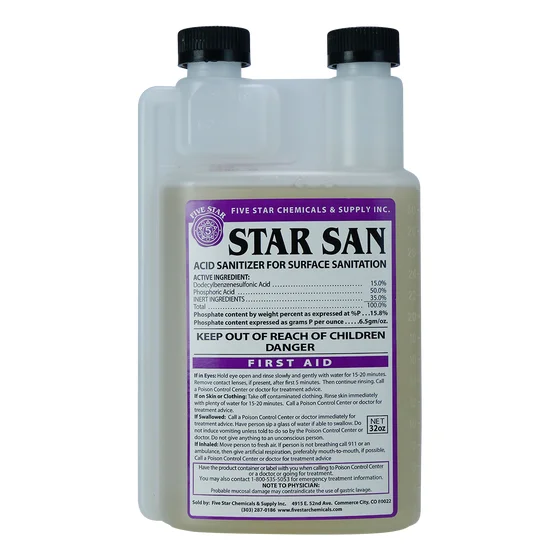
This week I take a look at sanitizers to use for beer brewing. In part 1 I presented an introduction to cleaning and sanitation and the importance of separately cleaning and sanitizing. Part 2 featured the most common cleaners used for beer brewing and their strengths and weaknesses.
Sanitizing
Sanitizing is the process of reducing the microorganisms on the surface of your brewing equipment to the point where they do not affect your fermentation or the long term stability of your beer. Sanitation is done after cleaning, since you it is kind of pointless to try to sanitize a surface that still has large organic or inorganic soils on it. Sanitizers are not designed to remove these soils, they are instead designed to kill microorganisms.
Sanitizing should be done with any equipment or surface that comes in contact with your wort or beer after it has been chilled below boiling. So, for example, I would sanitize my wort chiller, all tubing, fermenter, spoons, tools, pumps and everything used during fermentation. You also want to sanitize shortly before use, as organisms from your environment can collect on surfaces over time.
Beer and Pathogens
While there are a variety of wild yeasts as well as bacteria that can sour your beer and create an array of off flavors, the good news is that there are no known pathogens that naturally grow in beer. Alcohol, hop compounds, low pH, lack of nutrients, and lack of oxygen inhibit their growth. So while you may be capable of making some really sour, nasty tasting, awful looking beers, you don’t need to worry about actually killing anyone with it. There are two exceptions. The first is beers that lack one of the above protections such as very low alcohol beer, beer with no hops, high pH, etc. For these cases, pasteurization or filtering might be appropriate. The second exception is people with allergies to certain ingredients. For example if you make beer with peanut butter or shellfish, you probably don’t want to give it to someone with those specific allergies.
Common Brewing Sanitizers
The ideal sanitizer for home brewing should be non-caustic so it won’t burn your hands. It should be fast acting and you would prefer a no-rinse sanitizer. The problem with rinsing is that the rinse water from your faucet is not strictly sanitized and contains some microorganisms that can contaminate your just sanitized surface. You want a sanitizer that is very effective on bacteria like lactobacillus or pediococcus as these are the most common bacteria that can sour your beer.
- Bleach (Sodium Hypochlorate) – Bleach is cheap and an effective sanitizer, but it has some drawbacks. First, bleach requires rinsing and can leave a strong odor/flavor if you don’t properly rinse it. Second, it can be hard on plastics and even pit stainless steel if left in contact for an extended period of time. Third, it can be somewhat slow to act taking some 15 minutes to sanitize a surface. I don’t personally use bleach as a sanitizer any longer.
- Oxi-Clean or One Step (Sodium Percarbonate) – These are oxidizers that break down into sodium carbonate and hydrogen peroxide when dissolved in water. Many of you are probably familiar with hydrogen peroxide for medical use. While this can be used for both cleaning and sanitation, it does require a thorough rinse, and I don’t generally recommend it for use in bottling or fermentation. The reason is that if you leave any residue on your bottles or fermenter, you are effectively leaving an oxidizer in place. Oxidizers kick off oxygen when combined with other chemicals, and oxygen will spoil your finished beer. These are better used for cleaning than sanitizing.
- Iodophor (Iodine) – Iodine is also widely used in medical applications as a sanitizer and disinfect. Iodophor is technically iodine combined with a solubizer that makes it release free iodine when mixed with water. Iodophor is effective as a sanitizer, and does not require a rinse. Probably the only downside is that it can color plastics over time leaving a brown or burnt orange color.
- Commercial Sanitizers: Professional brewers have access to a variety of sanitizing agents including iodophor, starsan/saniclean, chlorine dioxide, peracetic acid, and other acid and ammonium based compounds. These are effective but not necessarily designed for home use.
- Starsan/Saniclean – (Phosphoric and dodeclybenzenesulfonic acid) – Starsan is a sanitizer designed for brewing. It is no-rinse, fast acting and can even be sprayed onto a surface from a spray bottle. Interestingly, these sanitizers actually break down quickly when the pH rises above 3.5 so the act of merely adding wort or beer to a vessel deactivates the sanitizer. These sanitizers don’t stain equipment either. The only real downside with Starsan is that it does generate a fair amount of harmless foam. Saniclean is a similar product that generates much less foam if you find the Starsan foam distracting.
Given the amount of sanitizer most home brewers use, it is probably best to choose a high quality sanitizer designed for home brewing. If you want to save some money, buy a larger package as most sanitizers have a relatively long shelf life.
I hope you enjoyed this week’s article on sanitizing your equipment. Next week in the final part 4, I will cover common bacteria and wild yeast flavors related to poor sanitation as well as some additional equipment and material issues related to cleaning and sanitation.
Please subscribe for regular weekly delivery, and don’t hesitate to retweet, link, like or mention any of my articles on social media.
Hi I have a question regarding sanitising equipment with sodium percarbonate. You mentioned that using this product requires a thorough rinse. I’ve used mangrove jacks no rinse sanitizer in the past and that is sodium percarbonate.
Are you able to shed some light on the confusion I have between rinsing and not rinsing please.